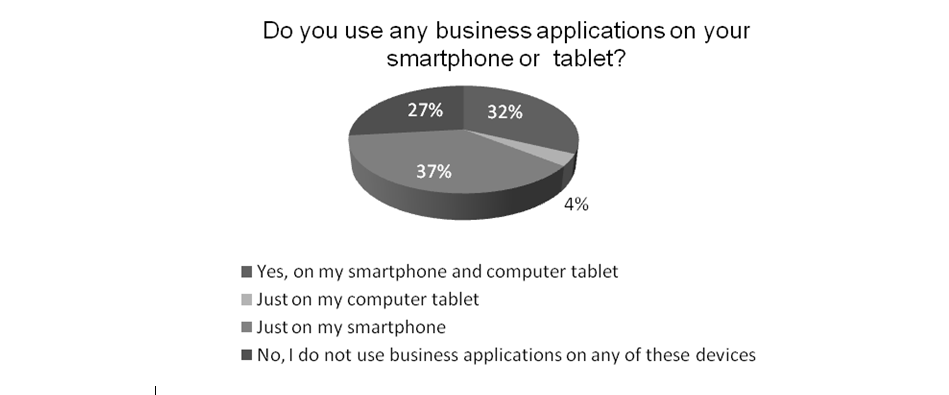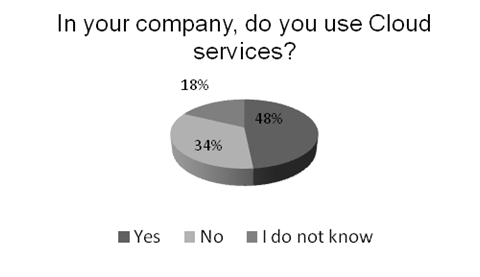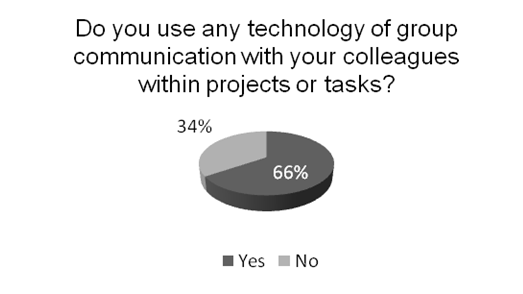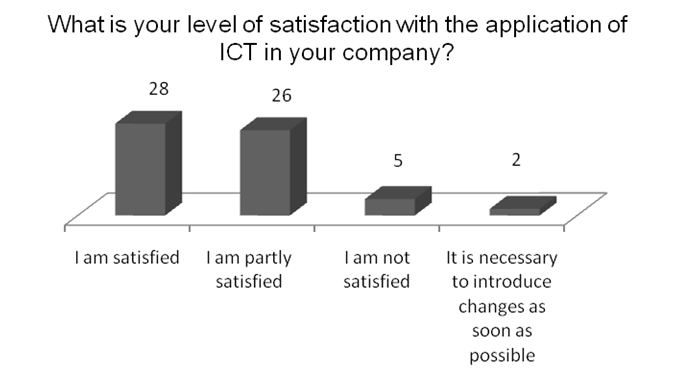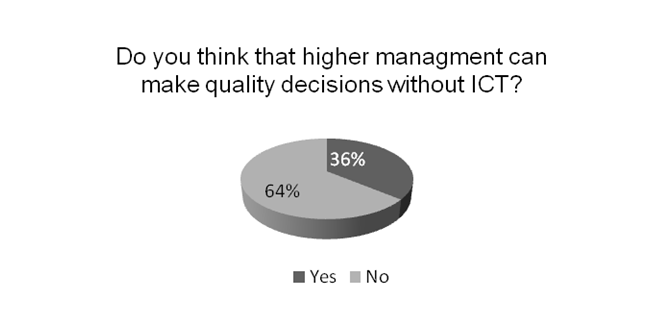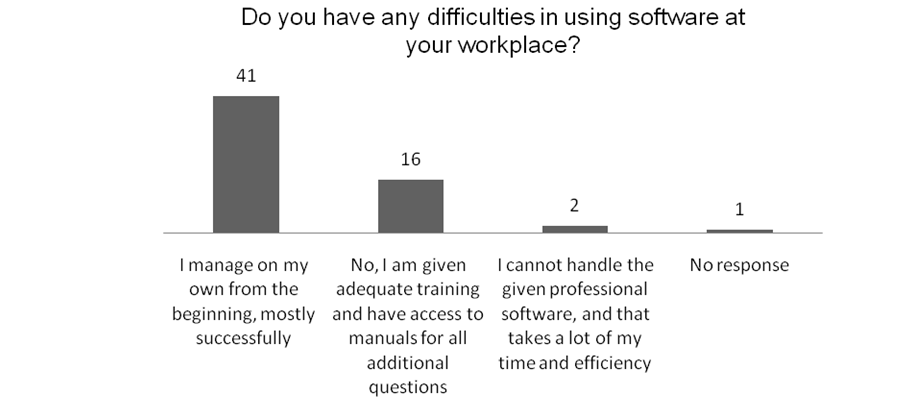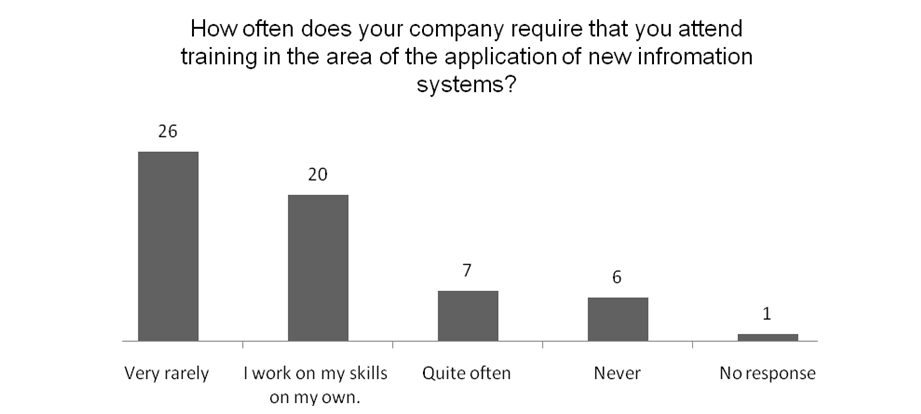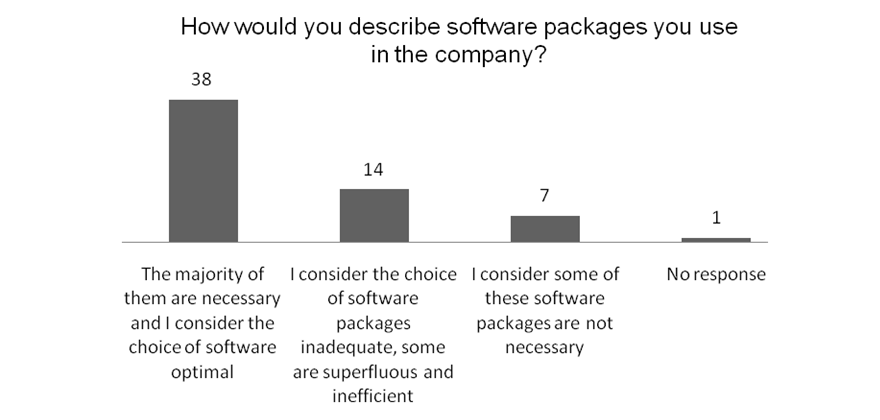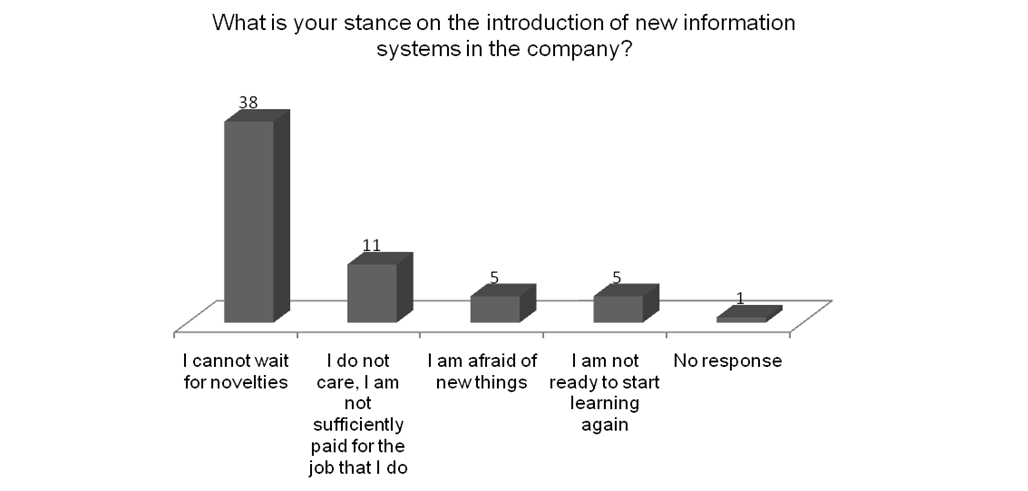1. INTRODUCTION
The conditions that characterize business activities are characterized by domestic and global competition, and this applies to the civil engineering market, as well. ICT has a role to facilitate and support business activities and to be a means of enabling efficient business management.
In case of civil engineering companies, it is possible to keep track of the efficiency of carrying out civil engineering services (projects), accompanying content, managing human resources, and relationships with clients, partners, etc. It is possible to conduct the aforementioned activities if suitable and adjusted software is used. The way in which business goals are accomplished, by detailed planning and choosing ICT, represents the alignment of ICT strategies with a business strategy.
The aim of this paper is to explore the characteristics of ICT, within the domain of Croatian civil engineering companies. Its purpose is to identify the most frequent problems and to highlight positive characteristics in relation to the area of the ICT government strategy. The identification of characteristics will be carried out by examining the attitudes of employees in the civil engineering industry, and in relation to the satisfaction with existing software packages, represented professional ICT tools, ways of using the same, ways of gaining necessary ICT skills and knowledge, the attitude toward and politics of managing ICT by superiors.
The set hypothesis of the survey is: there is no clear strategy of managing ICT in Croatian civil engineering companies.
2. RELATED WORK
Today thinking about business success is necessarily connected to new relevant information and communications technology (ICT) solutions. Information presents a crucial organizational resource and asset, and its expected potential is to create knowledge for undertaking optimal actions and decisions at every organizational level. The debate about the role of ICT in organizational success has been a topic of broad and current interest for the last few decades.
The field of ICT introduces two key factors for bringing innovation and initiating and carrying out change management within organizations – information and technology (Rossignoli et al., 2016;Ricciardi et al., 2012). They are considered in managerial world to be one of the most important sources for gaining competitive advantage and improving business performance (Melville et al., 2004). In the last few decades, organizations have been investing in ICT, but often planned and expected efficiency and effectiveness increase do not occur. In practice, many cases have shown how ICT adoption, without a detailed strategy on what, when, where and how, presents a big cost and no expected improval. ICT, therefore, presents a necessary condition, which is, however, not sufficient to ensure organizational prosperity (Rossignoli et al., 2016).
Successful implementation of ICT presents one of the greatest challenges for managers and it often occurrs at the same time as a redesign of business processes and organizational change management activities. Also, it is very demanding in the human resources domain because it requires learning, adopting and adapting all necessary changes (Gatti, 2007;Magni, Pennarola, 2008). Today’s business environment is facing an additional challenge with the implementation and continuous adaptation of organizational ICT due to the explosion of data from “everywhere” – online mobile or desktop business applications, various ERP (Enterprise Resource Planning), CRM (Customer Relationship Management) or SCM (Supply Chain Management) software packages, in Cloud or not. Social networks and other B2B web sites have become a new huge unexplored field of potentially valuable information. Those new conditions imply many difficulties for managing IT and knowledge activities in organizations and, therefore, new requirements in terms of methods and tools for effective knowledge managing (Malhotra, 2005). Software vendors develop different products with various functionalities in order that every organization finds its best ICT solution, but it also requires a deep and detailed organizational strategy for ICT adoption.
Today information technology means the support, sustainability, and growth of organizations. Nowadays it is impossible to avoid and ignore the fact that the existence of organizations and success depend on IT or better, ICT.De Haes and Grembergen (2015) andHirt and Wilmmott (2014) use the term “digital capability”, which, they state, will determine whether companies are going to experience gains in value or its loss. Furthermore,De Haes and Grembergen (2009) andWeill and Ross (2004) point that IT should be seen as a strategic partner within the digitilized organization. Regarding such an important role of IT for organizations’ value creation, broader consideration of IT-related strategic planning is recommended (De Haes and Grembergen, 2009,Thorp, 2003;Wilkin, Chenhall, 2010).
In addition to that, the scope of “alignment between the business and IT” comprises two important questions: “how is IT aligned with the business and how is the business aligned with IT” (Henderson, Venkatraman, 1993), and it implies the necessity of strategic integration – linking a business strategy with an IT strategy (De Haes and Grembergen, 2015). IT governance could be seen as the system on which an organization bases its IT management. It documents IT decision-making rights and responsibilities between different organizations’ stakeholders, the rules and procedures for decision making on strategic IT concerns (Peterson, 2004).
A difference between IT management and IT governance stems from the fact that IT management includes effective IT services and products and the IT operations management. IT governance is of a broader scope - it focuses on IT performance in order to satisfy present and future demands of the business and customers (Van Grembergen et al., 2004). The mechanisms of deploying IT governance differ among organizations depending on a business domain and the company's size - and there is no strategic pattern that will work for every organization (Patel, 2004).
Speaking of IT effect on profit or revenue growth enabled by IT or cost reduction as an IT-enabled consequence, results show a significant effect of IT on organizations’ profit, and that IT investments influence profit more through revenue growth and less through cost reduction (Mithas et al., 2012). The same authors state that the IT investments’ effects on profitability are higher than profit growth related to other investments such as advertising and R and D expenditures.
Pham et al. (2013) suggest that, if in an organization some of the following states were observed, they could be considered as a clear sign of misalignment between business and IT. Some of the characteristics are described as following:
no clear answer on IT specific contribution to the organization’s business strategy,
users have difficulties to use an IT solution (employers and/or customers),
existence of many IT departments or teams,
overlapping or redundancy in different IT systems, difficult and costly to modify,
errors and inconsistencies in organizations’ data reporting.
A situation where IT department’s work is not aligned with its respective organization’s business strategy is not a rarity. AuthorsPham et al. (2013) deliver some reasons for that:
IT is often occupied with urgent problems and issues, therefore, it has no time to dedicate to the creation of an IT roadmap to support strategy,
the tenure of a CIO (Chief Information Officer) is too short to create an IT roadmap for their organization,
a gap that prevents alignment of IT and business is due to the lack of business strategy practical knowledge on the IT side, and insufficient technology knowledge on the business side.
Regarding in particular civil engineering companies and ICT,Wong and Sloan (2004) point out that in comparison with other sectors (e.g. manufacturing, retail and finance services), civil engineering companies integrate less ICT in their business (Ng et al., 2001). Previous studies on ICT deployment in civil engineering companies have shown that large firms, more than small and medium ones, established ICT infrastructures and integrate ICT more intensively in their business, (Ng et al., 2001), (Love et al.,2000).
Love et al. (2000) found that the cost of not recognizing the potential of ICT in civil engineering companies might result in losing competitiveness or contracts.
Brewer et a. (2005) suggest that despite early optimism about the use of ICT to improve the productivity and profitability of the civil engineering industry, no consistent benefits have been perceived yet. The same authors describe their findings of case studies regarding critical success factors of ICT integration in supply chain processes, the main problems and barriers. They, also, advise some of the best practice guides for that area.
The civil engineering industry is challenged to change and improve business to become more client-oriented; more competitive and more productive through adoption and integration of ICT for the entire construction process (Weippert et al.,2003) . The use of ICT in construction is worth an effort because it can decrease the time for data processing, communicating information and increase overall productivity (Onyegiri et al., 2011). Modern structural design software applications, such as 3D modelling, provide an example of designing complex structures and organising everything that is needed. Furthermore, this can be achieved in minimum time and can increase the efficiency in one data framework (Peansupap, Walker, 2006). The authors (Onyegiri et al., 2011) point out that is important to understand the role of ICT for improving communication between participating organizations in construction projects.
Based on 70 papers presented in the workshop (Sarshar, Isikdag, 2004) some trends for the use of IT emerged:
ICT as the enabler of integration - use of 3D Modelling, Virtual Reality, Simulation software;
ICT as the enabler of Collaboration and Knowledge Management – Knowledge representation, discovery and knowledge management system, decision support suites, group communication possibilities, Object Oriented CAD;
ICT as the enabler of Procurement and Site Management – using Digital Catalogues, GIS Applications and Mobile Computing.
Isikdag et al. (2008) performed a comprehensive survey on the strategic role of ICT in Turkish civil engineering and architectural industry. InIsikdag et al. (2009) some of the results of that survey were discussed, which demonstrated that ICT is partially recognized as a value-adding resource in overall business strategy and for gaining competitive advantage: 1/3 of the organisations viewed ICT as crucial resources for competitiveness, and 38% saw ICT strategy as a critical element of their overall business strategy. Additionally, most of the organisations admitted not having a properly documented ICT strategy. The results show that ICT strategy is not yet at a high level where ICT activities are planned and managed according to a detailed documented strategy.
Regarding ICT investments, results show that they are not made for strategic reasons (competitive advantage) but only for processes support.
In another article, the same authors (Isikdag et al., 2008) found that the greatest problems for successfully implementing and managing ICT were: inefficient software use, ill-defined processes and infrastructure problems. On the other hand, factors for successful implementation of ICT were: quality planned ICT training, a re-design of the processes and support received form software vendors.
3. CIVIL ENGINEERING COMPANIES IN CROATIA
At the beginning of the 90s after gaining independence and sovereignty, complex, dynamic and demanding processes in the Republic of Croatia have begun to change governmental, social, economic and all other national systems which were inherited from the former Yugoslavia. These transitional changes included the alteration of governmental and social organization, democratization of the society, reforms of the financial, social, retirement and economic system, privatization and protection of private ownership, introduction of a market economy, reform of state administration and authorities. At lower levels, these reforms also encompassed also state systems which were in charge of jobs, which were of national interest.
After 1991, in a short time, significant changes occurred. The change of the economic system of the country and the introduction of a free market economy resulted in complete privatization of civil engineering companies, which were to that point state-owned, that is, the creation of the private sector in the civil engineering industry. Civil engineering companies in Croatia have experienced an expansion and the competition is growing stronger day by day.
The role of ICT is equally important as in other sectors because it enables faster, simpler and quicker adjustment of business processes. ICT is one of the main factors, which enables running of business processes via functional and organizational boundaries, that is, the existence of a process-oriented organization. The success of business processes is becoming more dependent on technology, a process automation, which confirms the necessity to connect two different elements of a business process – organizational and IT.
4. RESEARCH METHOD
The aim of the survey is to examine the attitudes of employees in civil engineering companies toward ICT governance and in relation to satisfaction with current software packages, represented professional ICT tools, the ways of using these, the means of gaining necessary ICT skills and knowledge, attitudes and politics of managing ICT by superiors in order to corroborate or contradict the set hypothesis.
This survey used the empirical inductive method. It was used to gather data, information, attitudes and opinions on the research topic, and the results of empirical research were analyzed using the support of appropriate mathematical, that is, statistical methods, in order for the gathered results to be used with the aim of proving the hypothesis.
The survey was carried out using a questionnaire, the analysis and descriptive method and synthesis. The questionnaire was created in open source tool LimeSurvey and it was sent via e-mail list to employees and managers of civil engineering companies in the Republic of Croatia. The questionnaire comprises 35 questions – 7 of them refer to demographic characteristics of employees and characteristics of companies in which they work, whereas the other 28 questions focus on gathering data on the most frequent software packages, ways of implementing and modalities of use the role they have in supporting business, decision-making, strategic planning and satisfying the management of ICT in companies. The answers that were given are explicit without the possibility of ambiguity in order for their interpretation to be more precise.
A total number of registered civil engineering companies in the Republic of Croatia is 18, 178. There are 15, 648 small companies, 122 medium-sized and 26 large companies. The size of 2, 382 companies has not been not defined. The questionnaire was sent randomly to e-mail addresses of 80 employees of mostly medium-sized and large (N=148) Croatian companies in the civil engineering sector. These companies have different legal and ownership structures.
5. RESEARCH RESULTS
Out of 80 participants in total, a sample of 57 correctly completed questionnaires was collected, which represents the return rate of 71.25%. The sample includes 38,5% of the population of medium-sized and large enterprises registered in civil engineering and can be considered as a representative sample. The majority of participants were companies that employ 26 to 50 employees (25.45%). According to the answer analysis, it is noted that there are 63.49% of limited liability companies, whereas there are 14.29% of joint-stock companies and 9.52% state companies. Asample of 40.32% regards the companies with one level of decision-making, 22.58% of them have two levels, whereas three or more decision-making levels are present in 37.1% of companies.
The questionnaire was completed by more male participants (77.19%) in comparison to the number of female participants (22.81%). Among the participants, the largest number of them are in 31-20 age group (53%). The majority holds an undergraduate degree (39%). The relation of responses regarding ICT literacy (66.67% think they did not have enough education) through the school system and the routine of using computers in everyday business commitments (98.25% use a computers) seems problematic.
During the further analysis it was expected that the companies would be using the Windows operating system (94.34%) to a greater extent although these licences are expensive in comparison to Linux, which is open-source and free, offering more possibilities (5.66%). If we analyze this result, we can conclude that commercialisation has affected all domains, making the choice of the operating system quite logical. It is an interesting fact that business trends have changed and there are more and more companies that buy a laptop computer for employees in order to make work at home possible (65.6%). The effects of the information and technological revolution are visible so the increase of the usage of smart phones or/and tablets (90.32%) was expected.
Figure 1 shows the participants’ perception of their use of mobile applications.
A positive trend of informatisation is recognized in the economic use of the Cloud service (Figure 2) as well as in the question whether they use some group communication technologies with colleagues in connection to projects and tasks (Figure 3), due to the fact 66% of them replied in the affirmative.
That implies that contemporary technologies enable team work and telework. The most represented is Viber (54.39%) followed by WhatsApp (33.33%) and Google chat (22.81%).
The majority of the respondents (64.15%) confirmed the existence of a system administrator in their company. It is interesting that 89.47% of them corroborate the existence of an external collaborator who is in charge of the surveillance of the information system. The question could be raised whether some companies spend their financial resources on some tasks that could be carried out by the system administrator. The satisfaction with the application of ICT technology in companies is not high (as seen inFigure 4).
The participants rated the importance of certain actvities to improve ICT in the following way (seeTable 1):
Source: designed by authors
The awareness of the importance of ICT implementation is confirmed by a high rate of affirmative answers (95%), as well as the opinion that top management cannot make decisions without using these (Figure 5). The respondents largely claim that when it comes to standard office software they use in a company, they utilize table computers, text processing software and some service applications on the Internet and/or an intranet.
The question whether there are problems with using software at their workplace and how they solve these, the surprising answer is that in most cases employees resolve these independently (Figure 6). In total, 48% of the respondents do not know what databases they use. The level of connection between databases within a company was assessed as satisfactory (57% claims that more than 50%-100% of data is interconnected).
In relation to the perception of allocating funds by management, 76% of them responded in the affirmative, whereas 24% of the participants oppose this claim. As the most frequent reason they mention the lack of interest of top management until there are problems regarding competitiveness (above 50%) and insufficient financial funds (50%), and some consider (around 25%) that this results from insufficient knowledge of ICT by top management.
The responses regarding the conduct and planning of training in the domain of ICT reveal poor organization in that area, as seen inFigure 7.
The respondents’ viewpoint on software packages in the company is shown inFigure 8.
The respondents are aware of the fact that managing business with the aid of ICT is important, where some are regarded equally important: due to the increase of productivity, decrease of expenses, increase of competitiveness and quality in conducting business, but opinions on the introduction of new information systems in the company are still partially negative (Figure 9).
By taking into consideration the analysed results of the survey, it is possible to draw the conclusion that the hypothesis (There is no clear strategy of managing ICT in Croatian civil engineering companies), can be accepted. Although there are some indicators that imply the recognition of the existence of an ICT strategy, this one is neither defined nor managed clearly to follow business activities and it contributes to the creation of a competitive advantage. Below (Table 2) there are some selected answers that corroborate the hypothesis.
Source: designed by authors
The following table (Table 3) confirms the conclusion that there is an attitude toward recognizing the value and potential of ICT in running a business, and there are some business practices that follow the developement of new ICT technologies.
Source: designed by authors
6. CONCLUSION
The significance and potential of ICT in everyday business is great, especially in the civil engineering sector, which in order to carry out many of its crucial activities, uses many ICT solutions. Also, ICT enables gathering and analysing data that will aid in controlling businesses and making decisions. It could be said that careful management of ICT enables and supports business activities of a civil engineering company and it is necessary to be familiar with business processes within one such organization. This demands cooperation of different branches of science - geotechnics, management, information and communication sciences.
This paper examines whether there is a clear strategy of managing ICT in Croatian civil engineering companies by taking into account employees’ attitudes. Although the results show that there is no clearly developed strategy to manage ICT, the importance of ICT for business quality and business success was recognized. The obstacles for setting the priorities for the development of an ICT strategy, which will keep up with business activities and even be the potential for creating additional value for companies, are numerous: insufficient education in relation to ICT in the formal part of education, chaotic planning of the additional training for employees, insufficient training for ICT software solutions, managers’ insufficient knowledge of the potential of ICT for business, lack of motivation by a certain number of employees, managers and employees’ distrust towards ICT. It is necessary to raise awareness to devise a viable ICT strategy, which integrates seamlessly with a business one, and then works comprehensively towards achieving business success.
Limitations of this research are a small number of participants, that is, companies. An increase of the sample would result in a survey of greater statistical significance in ICT governance among the companies of different characteristics. Also, the survey could be conducted exclusively at operative and/or strategic level of employees in order to determine their perception of significance of an ICT strategy for a business result, and their knowledge in relation to that aspect of running a company. A difference in ICT governance in small, medium and large civil engineering companies could be surveyed. Further research that will prove a cause and effect relationship between the ICT quality strategy and business progress is definitely a way to overcome these issues.

